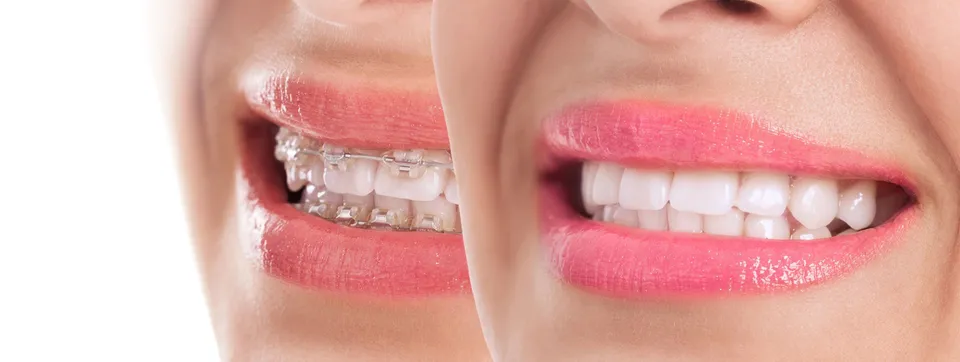

Verified by Dr. Jaimin Patel
Dr. Jaimin Patel is an eminent Master of Dental Surgery (MDS) and Dental Implantologist as well as he is considered one of the best dentists in Ahmedabad, Gujarat, India. He has done MDS (Master of Dental Surgery) from FOFP (USA).
Invisible braces, referred to by the name clear aligners are an increasingly popular option for those who want orthodontic treatment but without the obviousness, the traditional braces made of metal. Despite their increasing popularity, many myths and myths are associated with these contemporary orthodontic solutions. We’ll look at the top 10 misconceptions regarding invisible braces help you understand the confusion and assist you in making an informed choice regarding your dental health. 10 Myths about Invisible Braces You Should Stop Believing
1. Invisible Braces Are Only for Minor Corrections
One of the most common misconceptions concerning invisible braces is they’re only suitable for minor orthodontic problems. Many believe that they are not able to assist with more serious issues with dental alignment or more complex problems.
Information: Invisible braces, especially those made by top brands such as Invisalign can be extremely effective in treating a range of orthodontic problems, ranging from minor misalignments to complex issues with bites. Clear aligners can treat crossbites, overbites, underbites as well as crowded teeth and gaps. A dentist can assess your needs individually and decide whether invisible braces are the right choice for you.
2. 10 Myths About Invisible Braces You Should Stop Believing
Many people believe clear aligners can be uncomfortable because they are afraid they can cause pain or irritation. Although discomfort is an aspect of any orthodontic treatment the idea that invisible braces cause more pain than conventional braces is a myth.
Truth: Most people find clear aligners to be more comfortable than braces made of metal. The aligners are constructed from a soft plastic, which helps reduce the chance of irritation to gums as well as the interior of your mouth. The discomfort that occurs is typically short-lived and indicates that braces can bring your teeth into a more symmetrical position. In addition, because there are no wires or brackets, you won’t need to be concerned about sharp edges, or constant adjustments.
3. Invisible Braces Are Too Expensive
Many believe that clear aligners have an expensive price tag that makes them prohibitive for people of average income. Although it is real that invisible braces may be more costly than traditional braces, they’re generally more affordable than you would think.
Information: The cost of invisible braces can differ based on the extent of your treatment, the location, as well as the company you select. However, most insurance policies cover a percentage of the cost, and some dentists provide payment plans to facilitate the treatment. In addition, clear aligners could help you save money in the long run since they typically require fewer visits to the dentist and adjustments than conventional braces.
4. You Have to Wear Invisible Braces 24/7
There is a widespread belief that clear aligners should be worn all the time to ensure that they are effective. But this isn’t correct.
The truth: While it’s important to wear braces that are invisible for 20 to 22 hours per day, however, you can take them off while eating, drinking flossing, brushing, or eating. This flexibility is among the main advantages of clear aligners over conventional braces. They can also be taken out on special occasions such as a photo shoot or an event of a large scale but it’s important to follow the instructions of your dentist to make sure you’re in the right direction in the treatment plan you have in place.
5. Clear Aligners Take Longer Than Traditional Braces
Some think that clear aligners take more time to align teeth than conventional braces made of metal. While this was before the advent of clear aligners advances in orthodontic technology have enabled invisible braces to be as efficient and quick as traditional braces.
The truth: In many cases, clear aligners can help straighten your teeth in about the same amount of time as traditional braces, usually between 12 and 18 months. The exact time of treatment will depend on your particular dental needs. The most important factor to achieve faster results is to wear your aligners regularly and adhere to the instructions of your dentist.
6. Clear Aligners Aren’t Effective for Complex Dental Issues
Many people think that clear aligners are not able to treat more complex orthodontic problems including severe bite issues or crooked teeth.
Truth: Clear aligners can be used to treat a variety of dental issues, including complicated problems. The technology behind the modern clear aligners is continuously changing, which allows them to deal with more complex cases. With advancements in 3D imaging as well as personalized treatment strategies, clear aligners could provide effective solutions for a variety of patients, including those with extreme misalignment or problems with their bite. But, in extremely complicated situations, braces with traditional wires may be the best option.
7. You can eat anything you Would like With Clear Aligners
Clear aligners give greater flexibility than traditional braces However, there are some points to be aware of.
Information: You can remove your aligners for eating and drinking, however, it is crucial to remember that you shouldn’t consume beverages while using your alignments. Consuming food or drinks while wearing your aligners may cause them to become stained, damage their material, or cause the buildup of bacteria. It’s also recommended to clean your teeth following meals before taking your aligners out to maintain your oral hygiene.
8. Invisible Braces Don’t Require Maintenance
Many people believe that since invisible braces can be removed, they don’t require regular maintenance or attention.
Truth: While it’s true that clear aligners are simple to maintain, they have to be cleaned regularly. Aligners need to be cleaned with warm water and a soft brush to prevent plaque staining and build-up. In addition, you should follow the advice of your dentist on when it is time to change to the next aligners. Failure to follow this advice could hinder the progress in your therapy.
9. Anyone Can Use Invisible Braces
Another myth that is commonly heard is that everyone can wear invisible braces, regardless of their age or condition.
The truth: While many people could benefit from straight aligners that are clear, however not all are suitable. Clear aligners work best for teens and adults with full-grown teeth. Children and those who have specific dental problems, like excessive overcrowding, jaw misalignments, or severe might not be suitable patients for the invisible braces. It is important to talk to the dentist you see or an orthodontist to determine whether transparent aligners would be the ideal option for you.
10. Your Teeth Will Shift Back After Treatment
Many people are concerned about their teeth shifting back to their normal positions when they have completed treatment with invisible braces.
The truth: While some shifting occurs naturally with time wearing a retainer after the treatment has been completed is crucial to ensure your teeth remain in their place. The dentist you see will recommend the proper retainer to make sure the results last over time. Retainers are usually worn at night and assist in keeping your alignment as it was achieved by the treatment with clear aligners.
Conclusion
Invisible braces are a safe discrete, comfortable, and acoustic option to straighten your teeth. But, there are numerous misconceptions about this treatment. When you know the facts and remove the myths, you will be able to make an informed choice regarding which clear aligners might be a good option for you. Always consult with your dentist for advice on your choices and make sure you adhere to the guidelines recommended by your dentist for the best outcomes.
Written by Dr. Jaimin Patel – Updated on February 19, 2025
Learn More About Aligners
- Invisible Braces Cost in India: City Wise Comparison
- Top 9 Invisible Braces Brands in India
- Finding the Cheapest Invisible Braces Cost in India
- Invisible Braces vs. Traditional Braces: Which is More Cost-Effective?
- How to Save on the Cost of Invisible Aligners in India – Expert Tips
- Invisalign: 5 Reasons to Choose Clear Aligners
- 7 Reasons to Choose Invisalign Aligners
- Best Dental Clinics in India for Affordable Invisible Braces
- 10 Myths About Invisible Braces You Should Stop Believing